Waterfalls, Lynn Canal, Alaska
Back in May, I went on a cruise in Alaska, this is the 4th part of my ongoing series discussing the photographic opportunities I found. In previous editions, I covered the experience of a float plane excursion to Big Goat lake, hiking on Mendenhall Glacier, hiking the Mount Roberts trails, and riding the White Pass and Yukon Route. This time we’ll be looking at something that didn’t require getting off the ship, photographing the numerous glaciers that line the fjords of Alaska.
It’s hard to throw a stone in an Alaskan fjord and not hit a waterfall, at least in the spring. Two thousand foot or higher mountains pretty much line the fjords, and their collected winter snow needs somewhere to go as it melts in the spring. Then there are the rains of summer.
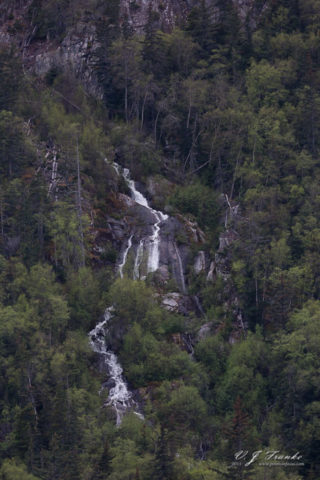
A quick look at a USGS topographic map shows nearly a dozen recognized streams flowing into the Taiya and Chilkoot inlets at the northern end of the Lynn Canal, and those are only the permeant ones that the USGS recognizes. In practice, especially in the spring, there will be a near continuous parade of waterfalls to see and photograph.
Making good images of these waterfalls poses a number of challenges, though I think the results can be worth it.
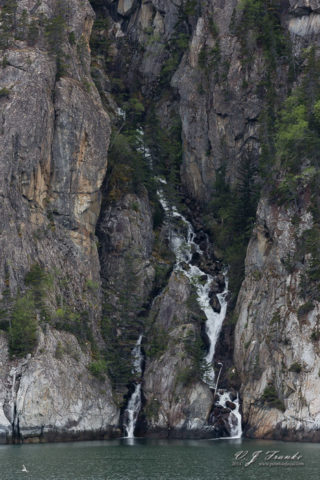
Typically when shooting waterfalls, you want to use a slow shutter speed, typically something slower than 1/30th of a second, to really blur the water into an attractive sheet instead of a series of frozen droplets. However, doing that generally demands a tripod and some steady ground to plant it on. While you might have a tripod, the ground is more of a problem.
If we assume for a moment that you’re not shooting from a cruise ship, steady ground is a challenge. Most of the fjords have no shore line to speak of. The granite walls simply plunge into the depths. Where there is somewhere on shore, more often than not it’s not a beach, but a flat area at the top of a low granite cliff. Ultimately, this means the odds are you’ll be shooting from a boat, and small boats aren’t the most stable boats.

If, like me, you’re on a cruise, the stability of the boat is less of a concern. A 1000 foot long, 20,000 ton displacement boat doesn’t rock and roll much in the relatively clam waters of these narrow channels. On the other hand, cruise ships don’t sit still. So while you might gain a more solid grounding to put a tripod, you gain a continuous 10–20 knots of forward motion.
Compounding my fun, I was shooting at almost 10 o’clock in the evening.
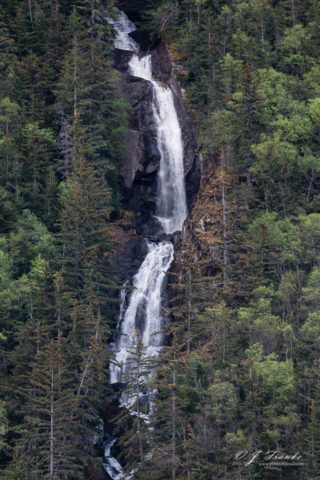
All told, I was absolutely floored by the performance of my gear in ways I never expected it to hold up. To start with I was regularly able to get reasonably sharp images at 1/40th of a second with my EF 100–400mm f/4.5–5.6L IS II USM at 400mm. Yes, the IS system is rated for 4 stops, so 1/30th would be the expected lower limit, and I was above that. However, in my experience the IS systems never actually preform as well as they’re advertised to. In addition to that, I, or at least the IS system, had to compensate for panning with the ship’s forward motion—which is nothing to sneeze at.
Moreover, shooting at nearly 10PM meant that I was shooting at ISO 1250–1600. Shooting at high ISOs has always been something I’ve never been real comfortable with. To be honest, I think a lot of this discomfort comes from Lightroom and the way it forces you to interact with images when dealing with sharpening and noise reduction. Specifically working at 100% on a low DPI monitor (like most still are), presents a magnified perspective of noise that just won’t be the same in a proper print. The other confounding factor might also be that in a lot of my work I end up with somewhat clean backgrounds that show the effects of noise more strongly than something with real texture.
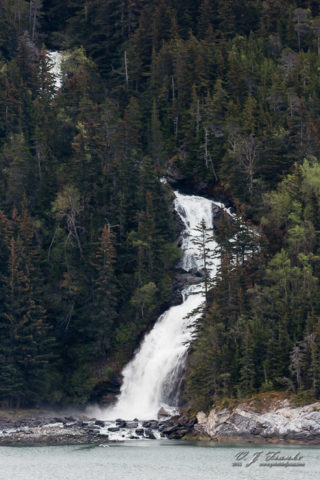
And I’ll be honest, it’s not that I considered the results from the 5D mark III unusable at these ISOs, but I didn’t consider it acceptable for the kinds of fine art work I’m interested in shooting and printing. What I discovered, is that under the right circumstances the results at ISO 1250–1600 are eminently usable to create high quality prints.
With that said, there’s not much to offer in the way of advice here. Like most “cruise landscapes” in Alaska, you’ll need a reasonably long lens. Every image I made was made between 300mm and 400mm on a full frame camera. For crop users, that would mean a lens that tops out in the 200–300mm range. Beyond that, having an image stabilized lens/camera I also see as a necessity, it’s the only practical way I see that you can get both shutter speeds around 1/30th of a second and a sharp image from a moving ship.
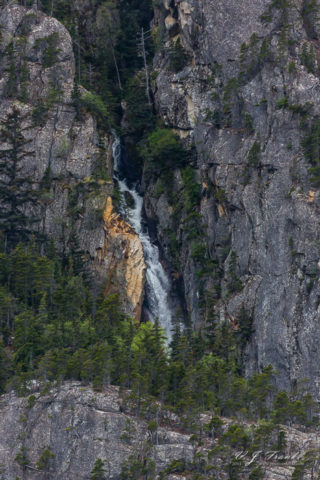
Comments
There are no comments on this article yet. Why don't you start the discussion?